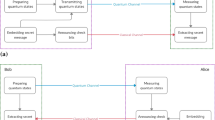Abstract
In this paper, we first propose a hidden rule among the secure message, the initial tensor product of two Bell states and the final tensor product when respectively applying local unitary transformations to the first particle of the two initial Bell states, and then present a high-efficiency quantum steganography protocol under the control of the hidden rule. In the proposed quantum steganography scheme, a hidden channel is established to transfer a secret message within any quantum secure direct communication (QSDC) scheme that is based on 2-level quantum states and unitary transformations. The secret message hiding/unhiding process is linked with the QSDC process only by unitary transformations. To accurately describe the capacity of a steganography scheme, a quantitative measure, named embedding efficiency, is introduced in this paper. The performance analysis shows that the proposed steganography scheme achieves a high efficiency as well as a good imperceptibility. Moreover, it is shown that this scheme can resist all serious attacks including the intercept-resend attack, measurement-resend attack, auxiliary particle attack and even the Denial of Service attack. To improve the efficiency of the proposed scheme, the hidden rule is extended based on the tensor product of multiple Bell states.
Similar content being viewed by others
References
Trithemius J. Steganographia. Frankfurt, 1606
Simmons G J. Advances in cryptology. In: Proceedings of Crypto 83. NewYork: Plenum Press, 1984. 51–67
Bailey K, Curran K. An evaluation of image based steganography methods. Multimed Tools Appl, 2006, 30: 55–88
Lin E T, Eskicioglu A M, Lagendijk R L, et al. Advances in digital video content protection. Proc IEEE, 2005, 93: 171–183
Bennett C H, Brassard G. Quantum cryptography: Public key distribution and coin tossing. In: Proceedings of IEEE International Conference on Computers, Systems and Signal Processing. New York: IEEE, 1984. 175–179
Ekert A K. Quantum cryptography based on Bell’s theorem. Phys Rev Lett, 1991, 67: 661–663
Bennett C H, Brassard G, Mermin N D. Quantum cryptography without Bell’s theorem. Phys Rev Lett, 1992, 68: 557–559
Goldenberg L, Vaidman L. Quantum cryptography based on orthogonal states. Phys Rev Lett, 1995, 75: 1239–1243
Zhou N R, Wang L J, Gong L H, et al. Quantum deterministic key distribution protocols based on teleportation and entanglement swapping. Opt Commun, 2011, 284: 4836–4842
Chen X B, Niu X X, Zhou X J, et al. Multi-party quantum secret sharing with the single-particle quantum state to encode the information. Quantum Inf Process, 2013, 12: 365–380
Chen X B, Wang T Y, Du J Z, et al. Controlled quantum secure direct communication with quantum encryption. Int J Quant Inform, 2008, 6: 543–551
Chen X B, Xu G, Yang Y X, et al. Centrally controlled quantum teleportation. Opt Commun, 2010, 283: 4802–4809
Hillery M, Buzek V, Berthiaume A. Quantum secret sharing. Phys Rev A, 1999, 59: 1829–1834
Gottesman D. Theory of quantum secret sharing. Phys Rev A, 2000, 61: 042311
Terhal B M, DiVincenzo D P, Leung D W. Hiding bits in Bell states. Phys Rev Lett, 2001, 86: 5807–5810
Eggeling T, Werner R F. Hiding classical data in multipartite quantum states. Phys Rev Lett, 2002, 89: 097905
DiVincenzo D P, Hayden P A, Terhal B M. Quantum data hiding. IEEE Trans Inf Theory, 2002, 48: 580–599
Guo G C, Guo G P. Quantum data hiding with spontaneous parameter down-conversion. Phys Rev A, 2003, 68: 044303
Hayden P, Leung D, Smith G. Multiparty data hiding of quantum information. Phys Rev A, 2005, 71: 062339
Chattopadhyay I, Sarkar D. Local indistinguishability and possibility of hiding cbits in activable bound entangled states. Phys Lett A, 2007, 365: 273–277
Zhang D X, Liao X Y. A quantum information hiding scheme using orthogonal product states. Wseas Trans Comput, 2007, 6: 757–762
Matthews W, Wehner S, Winter A. Distinguishability of quantum states under restricted families of measurements with an application to quantum data hiding. Commun Math Phys, 2009, 291: 813–843
Gea-Banacloche J. Hiding messages in quantum data. J Math Phys, 2002, 43: 4531–4536
Worley G G. Quantum watermarking by frequency of error when observing qubits in dissimilar bases. arXiv: Quant-ph/0401041v2, 2004
Matin K. Steganographic communication with quantum information. Lect Note Comput Sci, 2007, 4567: 32–49
Mogos G. Stego quantum algorithm. In: International Symposium on Computer Science and its Applications, Washington: IEEE Computer Society, 2008. 187–190
Mogos G. A quantum way to data hiding. Int J Multimed Ubiquitous Eng, 2009, 4: 13–20
Liao X, Wen Q Y, Sun Y, et al. Multi-party covert communication with steganography and quantum secret sharing. J Syst Softw, 2010, 83: 1801–1804
Shaw B A, Brun T A. Quantum steganography with noisy quantum channels. Phys Rev A, 2011, 83: 022310
Qu Z G, Chen X B, Niu X X, et al. Novel quantum steganography with large payload. Opt Commun, 2010, 283: 4782–4786
Qu Z G, Chen X B, Niu X X, et al. Quantum steganography with large payload based on entanglement swapping of χ-type entangled states. Opt Commun, 2011, 284: 2075–2082
Fatahi N, Naseri M. Quantum watermarking using entanglement swapping. Int J Theor Phys, 2012, 51: 2094–2100
Nielsen M A, Chuang I L. Quantum computation and quantum information. Cambridge: Cambridge University Press, 2000
Lin S, Wen Q Y, Gao F, et al. Quantum secure direct communication with χ-type entangled states. Phys Rev A, 2008, 78: 064304
Cai Q Y, Li B W. Improving the capacity of the Bostroem-Felbinger protocol. Phys Rev A, 2004, 69: 054301
Ashok J, Raj Y, Munishankaraiah S, et al. Steganography: An overview. Int J Eng Sci Technol, 2010, 2: 5985–5992
Author information
Authors and Affiliations
Corresponding author
Rights and permissions
About this article
Cite this article
Xu, S., Chen, X., Niu, X. et al. High-efficiency quantum steganography based on the tensor product of Bell states. Sci. China Phys. Mech. Astron. 56, 1745–1754 (2013). https://doi.org/10.1007/s11433-013-5151-0
Received:
Accepted:
Published:
Issue Date:
DOI: https://doi.org/10.1007/s11433-013-5151-0




